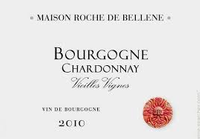Maison Roche de Bellene, Bourgogne Blanc (France) Chardonnay Vieilles Vignes 2010 (Loosen Bros., USA, $25): “Trust your wine merchant,” I frequently tell people who ask for advice in finding good wines. I recently took my own advice and tried a bottle of this white Burgundy, which a trusted retailer recommended. I was delighted with the wine’s quality, and in researching the wine discovered that it has something of a pedigree. Not only is the producer Nicolas Potel, a  respected figure in the Burgundy region, but also the U.S. importer is Loosen Bros., the U.S. arm of Ernst Loosen, who is highly regarded as a wine producer in Germany and also here in the States.
respected figure in the Burgundy region, but also the U.S. importer is Loosen Bros., the U.S. arm of Ernst Loosen, who is highly regarded as a wine producer in Germany and also here in the States.
Maison Roche de Bellene is the négociant operation of Nicolas Potel; he launched the company in 2008 after departing from his eponymous Burgundy négociant business, which he had started in 1996. It is a sister operation to Potel’s Domaine de Bellene, an estate producer owning 60 acres of biodynamically-farmed grapes in Burgundy. Potel’s focus for the négociant business is to be Burgundy’s only haute couture négociant, offering small production of higher quality wines than is the norm for négociant houses.
This wine is his entry-level white Burgundy. Its grapes come from old-vine parcels in the Côte de Beaune and Côte Chalonnaise, and the vines average 65 years of age.
As you would expect from a Bourgogne Blanc in a good vintage such as 2010, this wine is quite full-bodied and fully dry. Its aroma is broad and rich, suggesting honey, lemon, ripe apple and a delicate perfume. The wine’s flavors echo the aromas, but in your mouth the fresh acidity enlivens and lifts the flavors; the lemony flavors in particular stand out, contrasting with a subdued nutty note. Structurally, the vibrant acidity balances the wine’s full body, its ripeness of fruit, and an earthy, phenolic character that most likely comes from the grapes themselves rather than from oak. The wine’s texture is lightly creamy, and its finish is long, with a hint of sweetness of fruit on the finish that is not evident in the mouth.
Winemaking involved a native yeast fermentation, full malolactic conversion, and no lees stirring. The wine aged for 15 months in large oak barrels, only ten percent of which were new.
Because it is from the 2010 vintage — and because of its fresh acidity and fruity finish — this wine will probably develop nicely over the next few years. However, I plan to drink the bottles that I purchased sooner, over the next year; for me, the wine strikes just he right balance of richness and vibrancy right now. As a food accompaniment, I want mushrooms and cream — that is, earthy flavors combined with richness; pasta or white-sauced mushroom pizza could deliver this combination, or a buttery mushroom risotto.
90 Points
